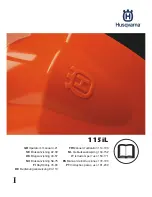
11
Punch Tool: This alternative to a blade is used to punch small holes for paper embroidery or Dutch paper
crafting. Place one of the accompanying rubber strips over the white cutting strip and materials can be
punched without using a mat.
Multi-Use Tool: While the Maxx and Groove E cutters have an adjustable blade holder seat, some pens or
embossing styluses may not fit properly. This is especially true if the bottom of the pen or stylus has a long
tapering to the tip. The Multi-
Use tool will fit pens and other tools up to ~11/32” or ~ 9 mm
in diameter.
Light Pressure Wheel Assembly: Similar to the existing pinch wheels, this light pressure version is an add-on
assembly used to control bowing of certain materials during cutting.
KNK MAXX
24” x 30” M
at: This extra large mat is
for use in the 24” KNK
MAXX machine.
1.6 Mat (Carrier Sheet)
Always use the mat to hold the material to be cut unless the material has its own protective backing.
If your mat arrived with a can of Krylon Easy Tack, carefully follow the directions on the can. Shake the can
well and place your mat on newspaper in a well-ventilated area such as a patio or inside a garage. Never
spray near other objects! Spray the top printed side back and forth vertically and horizontally, making sure
to cover the surface thoroughly, but do not soak. Allow about 30 minutes to dry.
While Krylon Easy Tack has proven to be an excellent mat adhesive for cutting paper and cardstock,
alternative adhesives may be used in place of the Krylon. If you are cutting thicker materials, such as
stiffened felt or styrene, then you may want to experiment with stronger adhesives or use pain
ter’s tape to
secure the material to the mat. If you are cutting thin paper, then you may want to experiment with lighter
adhesives.
Use a plastic scraper (an old credit card will suffice) to scrape off any random material pieces remaining on
the mat after a cut. For finer particles of paper or lint, you can use a lint roller. Tear off a sheet and then
press down and pull up across the surface of the mat to clean in sections.
When mats begin to lose their stickiness, they can be washed. Use a mild dishwashing detergent, warm
water, and a soft brush to thoroughly clean the surface. Then allow to thoroughly dry. Normally, the mat will
regain its original stickiness. But if not, spray again with Krylon.
If the newly-sprayed mat is too sticky, causing difficulty in removing paper pieces, dab an old, but clean T-
Shirt over the surface of the mat until stickiness is more appropriate for your material.
Avoid direct contact between the pinch wheels and the mat as the rubber on the wheels will tend to pick up
the adhesive and then later stick to the paper or cardstock you are cutting. If this happens, these rubber
wheels may be cleaned with isopropyl alcohol or Un-Du. Move the wheel away from a grit shaft, apply the
cleaner to a clean rag or paper towel, and rub the entire wheel until free of adhesive.
One alternative to spraying the entire mat with the adhesive is to mask off all areas except for those you
will be using and spraying only those areas. For example, if you only cut from 12
”
x 12
”
cardstock, then
only apply adhesive to that portion of the mat. This also economizes your usage of adhesive.
Alternatively, silicon spray or silicon grease can be applied to the rubber wheels and then the adhesive
from the mat will not stick to the rubber. Do not spray the wheels directly; instead spray a clean rag or a
paper towel and then apply the wet paper towel to the wheels, or use a cotton swab to apply the silicon to
the wheels.
1.7 Attaching the KNK Bolt-On Tables
The installation of the front and rear tables on your KNK is best done with two people. Each box contains 2
identical tables (front and rear) and 8 screws.












































